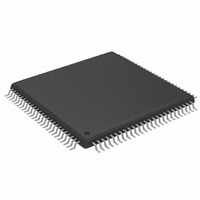XA2C256-7VQG100I Xilinx Inc, XA2C256-7VQG100I Datasheet - Page 18

XA2C256-7VQG100I
Manufacturer Part Number
XA2C256-7VQG100I
Description
IC CPLD 256MCELL 80 I/O 100-VQFP
Manufacturer
Xilinx Inc
Series
CoolRunner IIr
Datasheet
1.XA2C256-7VQG100I.pdf
(19 pages)
Specifications of XA2C256-7VQG100I
Programmable Type
In System Programmable
Delay Time Tpd(1) Max
7.0ns
Voltage Supply - Internal
1.7 V ~ 1.9 V
Number Of Logic Elements/blocks
16
Number Of Macrocells
256
Number Of Gates
6000
Number Of I /o
80
Operating Temperature
-40°C ~ 85°C
Mounting Type
Surface Mount
Package / Case
100-TQFP, 100-VQFP
Features
JTAG
Voltage
1.8V
Memory Type
CMOS
Lead Free Status / RoHS Status
Lead free / RoHS Compliant
Number Of Logic Elements/cells
-
Available stocks
Company
Part Number
Manufacturer
Quantity
Price
Company:
Part Number:
XA2C256-7VQG100I
Manufacturer:
XILINX
Quantity:
2 400
Company:
Part Number:
XA2C256-7VQG100I
Manufacturer:
XILINX
Quantity:
230
Part Number:
XA2C256-7VQG100I
Manufacturer:
XILINX/赛灵思
Quantity:
20 000
5. Avoid pull-down resistors. Always use external pull-up
6. Do not drive I/Os pins above the V
7. Do not rely on the I/O states before the CPLD
8. Use a voltage regulator which can provide sufficient
9. Ensure external JTAG terminations for TMS, TCK, TDI,
10. Attach all CPLD V
11. Decouple all V
12. Configure I/Os properly. CoolRunner-II Automotive
Recommendations
The following recommendations are for all automotive appli-
cations.
Additional Information
Additional information is available for the following CoolRunner-II topics:
•
•
•
•
•
•
•
DS555 (v1.2) June 22, 2009
Product Specification
resistors if external termination is required. This is
because the CoolRunner-II Automotive CPLD, which
includes some I/O driving circuits beyond the input and
output buffers, may have contention with external pull-
down resistors, and, consequently, the I/O will not
switch as expected.
I/O bank.
a. The current flow can go into V
b. It can also increase undesired leakage current
c. If done for too long, it can reduce the life of the
configures. During power up, the CPLD I/Os may be
affected by internal or external signals.
current during device power up. As a rule of thumb, the
regulator needs to provide at least three times the peak
current while powering up a CPLD in order to guarantee
the CPLD can configure successfully.
TDO should comply with the IEEE 1149.1. All Xilinx
CPLDs have internal weak pull-ups on TDI, TMS, and
TCK.
necessary power and ground supplies around the
CPLD.
0.01 μF and 0.1 μF closest to the pins for each
V
CPLDs have I/O banks; therefore, signals must be
assigned to appropriate banks (LVCMOS33,
LVCMOS18 …).
XAPP784: Bulletproof CPLD Design Practices
XAPP375: Timing Model
XAPP376: Logic Engine
XAPP378: Advanced Features
XAPP382: I/O Characteristics
XAPP389: Powering CoolRunner-II
XAPP399: Assigning VREF Pins
CC
voltage regulator.
associated with the device.
device.
/V
CCIO
R
-GND pair.
CC
and V
CC
and GND pins in order to have
CCIO
pins with capacitors of
CCIO
CCIO
and affect a user
assigned to its
www.xilinx.com
1. Use strict synchronous design (only one clocking event)
2. Include JTAG stakes on the PCB. JTAG stakes can be
3. CoolRunner-II Automotive CPLDs work with any power
4. Do not disregard report file warnings. Software
5. Understand the Timing Report. This report file provides
6. Review Fitter Report equations. Equations can be
7. Let design software define pinouts if possible. Xilinx
8. Perform a post-fit simulation for all speeds to identify
9. Distribute SSOs (Simultaneously Switching Outputs)
10. Terminate high speed outputs to eliminate noise caused
These and other application notes can be accessed at:
CoolRunner-II Documentation
Package specifications can be accessed at:
Device Packages
if possible. A synchronous system is more robust than
an asynchronous one.
used to test the part on the PCB. They add benefit in
reprogramming part on the PCB, inspecting chip
internals with INTEST, identifying stuck pins, and
inspecting programming patterns (if not secured).
sequence, but it is preferable to power the V
V
glitches from device I/Os are unwanted.
identifies potential problems when compiling, so the
report file is worth inspecting to see exactly how your
design is mapped onto the logic.
a speed summary along with warnings. Read the timing
file (*.tim) carefully. Analyze key signal chains to
determine limits to given clock(s) based on logic
analysis.
shown in ABEL-like format, or can also be displayed in
Verilog or VHDL formats. The Fitter Report also
includes switch settings that are very informative of
other device behaviors.
CPLD software works best when it selects the I/O pins
and manages resources for users. It can spread signals
around and improve pin-locking. If users must define
pins, plan resources in advance.
any possible problems (such as race conditions) that
might occur when fast-speed silicon is used instead of
slow-speed silicon.
evenly around the CPLD to reduce switching noise.
by very fast rising/falling edges.
CC
) before the V
XA2C256 CoolRunner-II Automotive CPLD
CCIO
for the applications in which any
CCI
(internal
18




















